
I have been holding out way too long on giving one of the great Roman pizzas, pizza con potate e rosmarino (which, like most things, sounds much sexier in Italian than the thudful translation of “potato pizza with rosemary”) the adoration-driven revisit it deserves on this site. I first talked about potato pizza here in 2008, but I never felt that the recipe did it justice. Jim Lahey, who had recently blown up everything we knew about making bread with his brilliant no-knead boule, was preparing to open a pizza place and had shared his potato pizza recipe with Martha Stewart, but I’d had trouble with it — the proportions seemed off (not enough potato, a persnickety dough), it was low on details I needed (like how big it was supposed to be), and it had pesky steps (like soaking the potatoes in several changes of ice water, so not fun if one lacks one of those fancy fridges with icemakers). But it wasn’t until went to Rome in 2013 that I realized exactly how far off it was from the ideal. (Don’t worry, Lahey is going to come rescue us in a bit.)
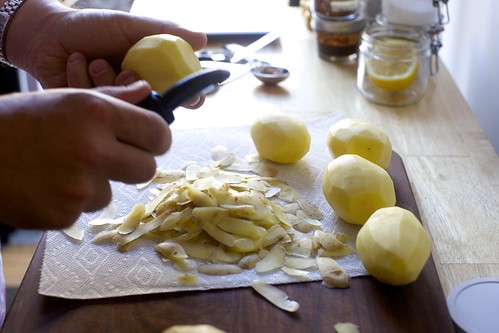
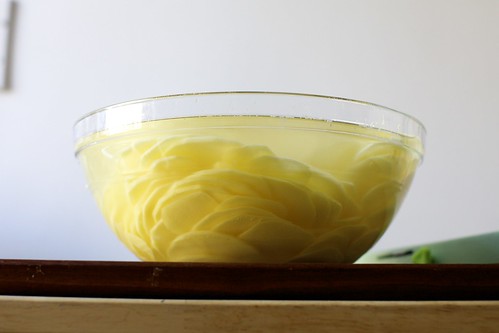
Roman pizza con patate is something else. A soft, almost goopy dough, is neither rolled or even tossed in the air like some sort of cartoon, but stretched, pressed, nudged and patted with oiled or floured fingertips translucently thin into a rimmed rectangular pan. Potatoes that have been soaked in salt water until they’re as floppy as deli slices are spread in many layers all the way to the edges, and even thicker there, as it will get darkest most quickly. From the oven, the crust is chewy and crisp and the most buried layers of potato become soft while the ones on top curl, brown and crisp like potato chips, and yes, that means you can tell everyone you’re eating potato chip pizza for dinner and watch the pangs of envy spread across their face.
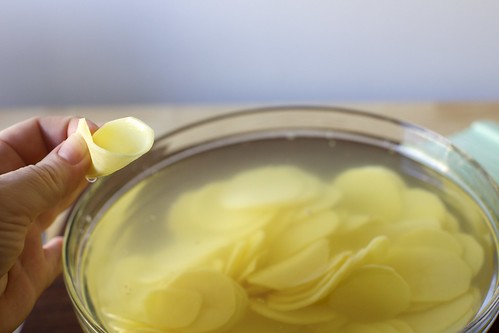
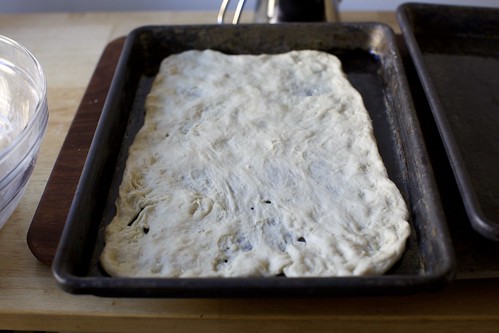
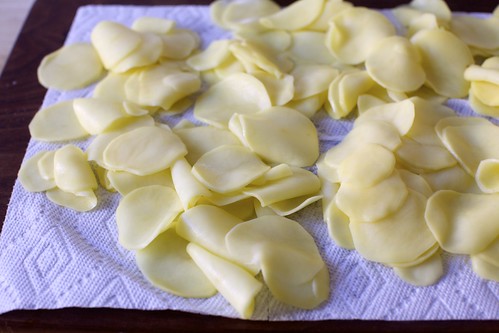

A study in minimalism, like most Roman cooking, it’s also something of a weeknight triumph — it requires all of three ingredients (potatoes, onion and rosemary) besides olive oil, salt, pepper, water, flour, yeast, which means it’s also vegan. It sounds like something that would be very heavy, but it’s quite the opposite; our favorite way to eat it is alongside a green salad or, if you’ve gotten your hand on asparagus, ramps and other spring delights and it’s not, say, 42 degrees where you are right now, we love it with spring vegetables.
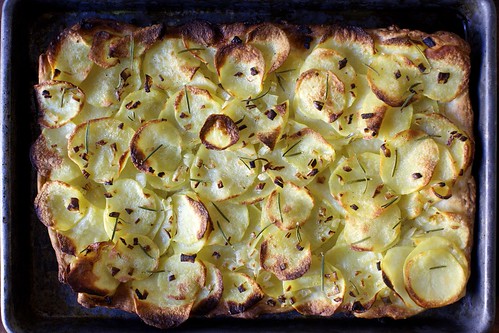
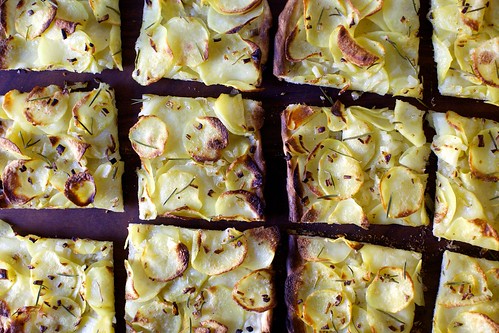
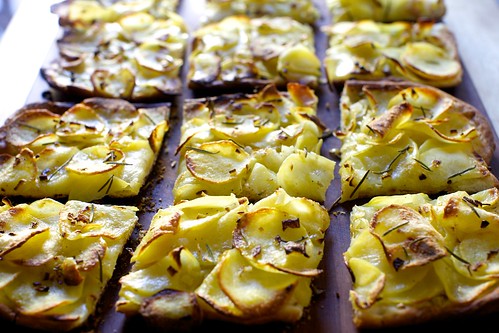
A few other pizza favorites:






One year ago: Obsessively Good Avocado Cucumber Salad
Two years ago: Three Bean Chili
Three years ago: Lentil and Chickpea Salad with Feta and Tahini
Four years ago: Over-The-Top Mushroom Quiche
Five years ago: Apple Tarte Tatin, Anew
Six years ago: Hazelnut Chocolate Thumbprint Cookies and Baked Kale Chips
Seven years ago: Beef Empanadas
Eight years ago: Shaker Lemon Pie
Nine years ago: Arugula Ravioli and Mixed Berry Pavlova
And for the other side of the world:
Six Months Ago: S’More Cupcakes
1.5 Years Ago: The Crispy Egg
2.5 Years Ago: Frico Grilled Cheese Sandwiches
3.5 Years Ago: Spaghetti with Broccoli Cream Pesto
4.5 Years Ago: Apple Pie Cookies
Potato Pizza, Even Better
Adapted from Jim Lahey’s My Bread
Notes:
- A tiny bit more context: Potato pizza is one kind the pizza al taglio that is considered daytime pizza in Rome, baked in electric ovens in large rectangular or oblong shapes, cut with scissors to the size you desire, and sold by weight. Wood-burning ovens historically weren’t allowed to run until 6 p.m. in Rome, and this was the delicious modification that emerged. Potato pizza is a variation on the gold standard of Roman bread, pizza bianca — pizza with just olive oil, rosemary and salt that amounts to so much more than it sounds.
- Did you read that part about the electric oven? Unlike most of the pizza gushed over these days, this is not pizza optimized for 900-degree pizza ovens notably absent in most homes, but the ovens we already have. Not that it wouldn’t be amazing in a wood-fired pizza oven, but if you don’t have one in that cramped studio walk-up, you’re not going to start this recipe already at a loss.
- Despite struggling with his first printed version, Lahey himself came to the rescue in 2012 with a much easier to follow potato pizza recipe in his first book that I’ve had great success with, so let us all applaud the silent co-authors of cookbooks that make great chef recipes work for the rest of us. The newer version lets us know exactly how big of a tray you’ll need, uses more potatoes, a simpler process of preparing them and I mean, just look at the results. (Well, not too closely. I was busy with a baby a nearly burnt mine.)
- Want to make this with sweet potatoes? Lahey says that this version [Pizza Batata] should be made with slightly more water (4 1/2 cups) for the same amount of salt, and that 2 sweet potatoes (800 grams) is all you’ll need. Skip the rosemary.
1 recipe pizza dough (below) or about a 2/3 volume of my lazy fitted-to-your-schedule favorite or your favorite, whichever it may be
4 teaspoons fine sea or table salt
6 to 8 (1 kilo) small to medium Yukon Gold potatoes, peeled
1 medium yellow onion, diced
1/2 teaspoon freshly ground black pepper
4 to 5 tablespoons olive oil
About 1 tablespoon fresh rosemary leaves
In a medium bowl, combine the 1 quart lukewarm water with salt, stirring until the salt has dissolved. Use a mandoline or your best sharpest knife to slice the potatoes very thin (1/16 inch thick), and put the sliced directly into the salted water, which prevents oxidation and also helps soften them so they cook up nicely. Lahey says to let them soak for 1 1/2 hours or up to 12 in the fridge overnight, but I was quite happy with my results after a 25 to 30 minute soak.
Heat your oven to 500°F with a rack in the center. Brush either 1 13×18-inch rimmed half-sheet pan or 2 9×13-inch quarter-sheet pans (shown) with olive oil. Divide your risen dough in half and use your fingertips, oiled or dusted with flour, to pull, stretch, nudge and press the dough across the bottom of the pan. The dough will be thin and imperfect. If holes form, just pinch them together. It’s all going to work out, promise.
Drain the potatoes in a colander and use your hands to press out as much water as possible, then pat dry on paper towels. In a medium bowl, toss the potato slices with the onion, pepper, and olive oil. Spread this potato mixture over your potato mixture evenly over the dough, going all the way to the edges of the pan; put a bit more topping around the edges of the pie, as the outside tends to cook more quickly. Sprinkle evenly with rosemary. Usually the salt the potatoes were soaked in is enough, but you can sprinkle more on if desired.
Bake for 25 to 30 minutes, until the topping is starting to turn golden brown and the crust is nicely bronzed underneath. Serve pizza hot or at room temperature.
Jim Lahey’s Basic Pizza Dough
This is halved and modified slightly
2 cups minus 1 tablespoon (250 grams) all-purpose or bread flour
1 1/4 teaspoons (5 grams) instant or active dry yeast
A heaped 1/4 teaspoon fine sea or table salt
A heaped 1/4 teaspoon granulated sugar
2/3 cups (150 grams) room temperature water
In a medium bowl, stir together the flour, yeast, salt, and sugar. Add the water and, using a wooden spoon or your hand, mix until well blended, about 30 seconds. Cover the bowl and let sit at room temperature until the dough has more than doubled in volume, about 2 hours. Continue using instructions above.
Source: http://feedproxy.google.com/~r/smittenkitchen/~3/P4PS7Jhmd50/